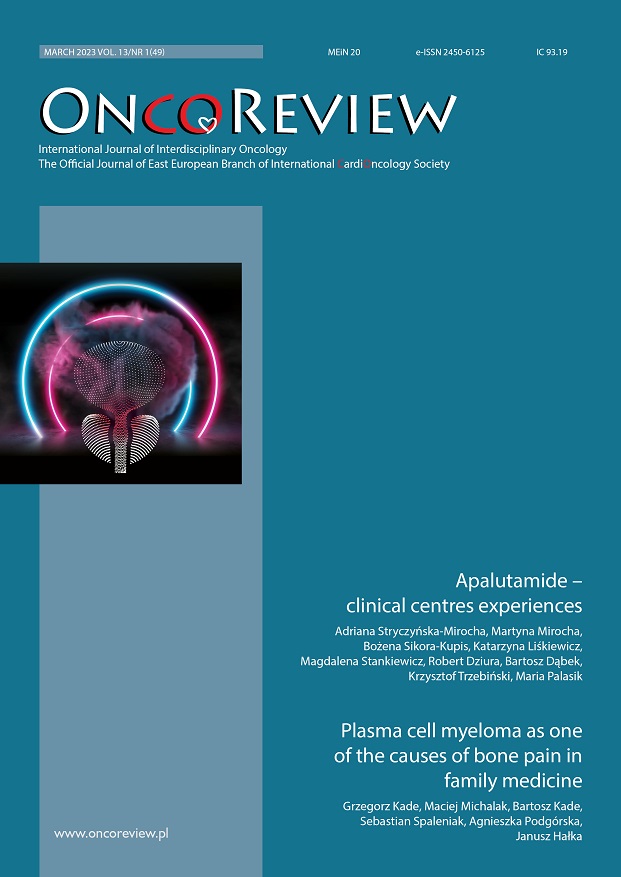Apalutamide as a therapeutic option in case of local failure in the nmCRPC Case report
Main Article Content
Abstract
Apalutamide is a non-steroidal selective androgen receptor inhibitor approved for the treatment of high-risk non-metastatic castration-resistant prostate cancer and metastatic hormone-sensitive prostate cancer. The paper describes a case of a patient diagnosed with prostate cancer with a long-term course of the disease. The patient was diagnosed with a non-metastatic castration-resistant stage 18 years after primary treatment. Systemic treatment with apalutamide was recommended. Initially, the treatment was carried out as part of the extended access to apalutamide program and from March 2022 as part of the B.56 drug program. The study presents the effectiveness and safety of the therapy in a 12-month follow-up period and discusses controversial aspects of the patient's previous treatments.
Downloads
Metrics
Article Details
Copyright: © Medical Education sp. z o.o. This is an Open Access article distributed under the terms of the Attribution-NonCommercial 4.0 International (CC BY-NC 4.0). License (https://creativecommons.org/licenses/by-nc/4.0/), allowing third parties to copy and redistribute the material in any medium or format and to remix, transform, and build upon the material, provided the original work is properly cited and states its license.
Address reprint requests to: Medical Education, Marcin Kuźma (marcin.kuzma@mededu.pl)
References
2. Mottet N, Cornford P, van den Bergh RCN et al. EAU-EANM-ESTRO-ESUR-ISUP -SIOG Guidelines on Prostate Cancer 2022. Eur Urol. In: EAU Guidelines. Edn. presented at the EAU Annual Congress Amsterdam 2022; EAU Guidelines Office, Arnhem, the Netherlands. Online.
3. Cox J, Grignon D, Kaplan R et al. Consensus statement: guidelines for PSA following radiation therapy. Int J Radiat Oncol Biol Phys. 1997; 37: 1035-41.
4. Miszczyk M, Jabłońska I, Krzysztofiak T et al. Does Brachytherapy Boost Improve Biochemical Control in Intermediate and High-Risk Prostate Cancer Patients Compared to External Beam Radiotherapy Alone? Int J Radiat Oncol. 2021; 111(3): e286-7.
5. Jereczek-Fossa BA, Beltramo G, Fariselli L et al. Robotic image-guided stereotactic radiotherapy, for isolated recurrent primary, lymph node or metastatic prostate cancer. Int J Radiat Oncol Biol Phys. 2012; 82(2): 889-97.
6. Vavassori A, Jereczek-Fossa BA, Beltramo G et al. Image-guided robotic radiosurgery as salvage therapy for locally recurrent prostate cancer after external beam irradiation: Retrospective feasibility study on six cases. Tumori. 2010; 96(1): 71-5.
7. Arcangeli S, Agolli L, Donato V. Retreatment for prostate cancer with stereotactic body radiation therapy (SBRT): Feasible or foolhardy? Reports Pract Oncol Radiother. 2015; 20(6): 425-9. http://dx.doi.org/10.1016/j.rpor.2014.08.001.
8. Jereczek-Fossa BA, Marvaso G, Zaffaroni M et al. Salvage stereotactic body radiotherapy (SBRT) for intraprostatic relapse after prostate cancer radiotherapy: An ESTRO ACROP Delphi consensus. Cancer Treat Rev. 2021; 98: 102206.
9. Scher N, Bauduceau O, Bollet M et al. Stereotactic prostate focal reirradiation therapy for local recurrence: preliminary results of Hartmann Oncology Radiotherapy Group. BJR Open. 2019; 1(1): 20180027.
10. Mbeutcha A, Chauveinc L, Bondiau PY et al. Salvage prostate re-irradiation using high-dose-rate brachytherapy or focal stereotactic body radiotherapy for local recurrence after definitive radiation therapy. Radiat Oncol. 2017; 12(1): 1-10.
11. Chitmanee P, Tsang Y, Tharmalingam H et al. Single-Dose Focal Salvage High Dose Rate Brachytherapy for Locally Recurrent Prostate Cancer. Clin Oncol. 2020; 32(4): 259-65. http://doi.org/10.1016/j.clon.2019.10.008.
12. Maenhout M, Peters M, van Vulpen M et al. Focal MRI-Guided Salvage High-Dose-Rate Brachytherapy in Patients With Radiorecurrent Prostate Cancer. Technol Cancer Res Treat. 2017; 16(6): 1194-201.
13. Tharmalingam H, Tsang Y, Ostler P et al. Single dose high-dose rate (HDR) brachytherapy (BT) as monotherapy for localised prostate cancer: Early results of a UK national cohort study. Radiother Oncol. 2020; 143: 95-100. http://doi.org/10.1016/j.radonc.2019.12.017.
14. Siddiqui ZA, Gustafson GS, Ye H et al. Five-Year Outcomes of a Single-Institution Prospective Trial of 19-Gy Single-Fraction High-Dose-Rate Brachytherapy for Low- and Intermediate-Risk Prostate Cancer. Int J Radiat Oncol Biol Phys. 2019; 104(5): 1038-44. http://doi.org/10.1016/j.ijrobp.2019.02.010.
15. Salari K, Ye H, Sebastian E et al. 21 Gy Single Fraction Prostate HDR Brachytherapy: Mature Results of a Single Institution Prospective Study. Brachytherapy. 2022; 21(6): S22.
16. Schaeffer EM, Srinivas S, Adra N et al. NCCN Guidelines® Insights: Prostate Cancer, Version 1.2023. J Natl Compr Canc Netw. 2022; 20(12): 1288-98.
17. Smith MR, Saad F, Chowdhury S et al. Apalutamide Treatment and Metastasis-free Survival in Prostate Cancer. N Engl J Med. 2018; 378(15): 1408-18.
18. Smith MR, Saad F, Chowdhury S et al. Apalutamide and Overall Survival in Prostate Cancer. Eur Urol. 2021; 79(1): 150-8.
19. Small EJ, Saad F, Chowdhury S et al. Apalutamide and overall survival in non-metastatic castration-resistant prostate cancer. Ann Oncol. 2019; 30(11): 1813-20. http://doi.org/10.1093/annonc/mdz397.
20. Sternberg CN, Fizazi K, Saad F et al. Enzalutamide and Survival in Nonmetastatic, Castration-Resistant Prostate Cancer. N Engl J Med. 2020; 382(23): 2197-206.
21. Fizazi K, Shore N, Tammela TL et al. Darolutamide in nonmetastatic, castration-resistant prostate cancer. N Engl J Med. 2019; 380(13): 1235-46.

